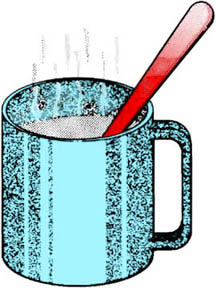
Think about heating some food on the stove using a metal or glass pan. You have learned that one of the chemical properties of metallic elements is that they are good heat conductors. Heat travels through metal and other solid objects by a process called
conduction. The stove heats the bottom of the pan, and the heat travels through the pan to reach the food, warming it up.
Conduction is the main way heat is transferred in solids. It happens when the molecules in the heated part of the object begin to move faster. Using the example from above, the heat energy from the stove is transferred to the molecules in the metal pan. The molecules in the pan move faster and faster, with those nearest the heat source (gas flame or electric burner) bumping into those around them, causing them to move faster. Those molecules in turn bump into other molecules, and eventually the heat energy moves through the solid metal. The heat energy is transferred in a pattern out and away from the directly heated part of the pan to the rest of the pan.
Some solids transfer heat quickly and easily, making them good conductors of heat. Most metals are good conductors of heat, although some are better than others. For example, copper and silver are more efficient heat conductors than steel or iron.
 Think about heating some food on the stove using a metal or glass pan. You have learned that one of the chemical properties of metallic elements is that they are good heat conductors. Heat travels through metal and other solid objects by a process called conduction. The stove heats the bottom of the pan, and the heat travels through the pan to reach the food, warming it up.
Think about heating some food on the stove using a metal or glass pan. You have learned that one of the chemical properties of metallic elements is that they are good heat conductors. Heat travels through metal and other solid objects by a process called conduction. The stove heats the bottom of the pan, and the heat travels through the pan to reach the food, warming it up.